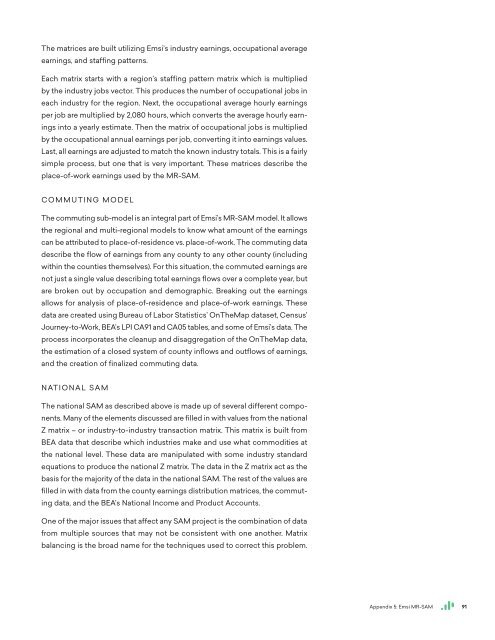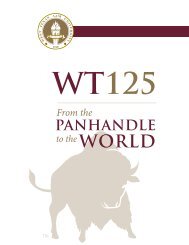The Economic Value of WTAMU Main Report
This report assesses the impact of West Texas A&M University (WTAMU) on the regional economy and the benefits generated by the university for students, taxpayers, and society. The results of this study show that WTAMU creates a positive net impact on the regional economy and generates a positive return on investment for students, taxpayers, and society.
This report assesses the impact of West Texas A&M University (WTAMU) on the regional economy and the benefits generated by the university for students, taxpayers, and society. The results of this study show that WTAMU creates a positive net impact on the regional economy and generates a positive return on investment for students, taxpayers, and society.
Create successful ePaper yourself
Turn your PDF publications into a flip-book with our unique Google optimized e-Paper software.
<strong>The</strong> matrices are built utilizing Emsi’s industry earnings, occupational average<br />
earnings, and staffing patterns.<br />
Each matrix starts with a region’s staffing pattern matrix which is multiplied<br />
by the industry jobs vector. This produces the number <strong>of</strong> occupational jobs in<br />
each industry for the region. Next, the occupational average hourly earnings<br />
per job are multiplied by 2,080 hours, which converts the average hourly earnings<br />
into a yearly estimate. <strong>The</strong>n the matrix <strong>of</strong> occupational jobs is multiplied<br />
by the occupational annual earnings per job, converting it into earnings values.<br />
Last, all earnings are adjusted to match the known industry totals. This is a fairly<br />
simple process, but one that is very important. <strong>The</strong>se matrices describe the<br />
place-<strong>of</strong>-work earnings used by the MR-SAM.<br />
COMMUTING MODEL<br />
<strong>The</strong> commuting sub-model is an integral part <strong>of</strong> Emsi’s MR-SAM model. It allows<br />
the regional and multi-regional models to know what amount <strong>of</strong> the earnings<br />
can be attributed to place-<strong>of</strong>-residence vs. place-<strong>of</strong>-work. <strong>The</strong> commuting data<br />
describe the flow <strong>of</strong> earnings from any county to any other county (including<br />
within the counties themselves). For this situation, the commuted earnings are<br />
not just a single value describing total earnings flows over a complete year, but<br />
are broken out by occupation and demographic. Breaking out the earnings<br />
allows for analysis <strong>of</strong> place-<strong>of</strong>-residence and place-<strong>of</strong>-work earnings. <strong>The</strong>se<br />
data are created using Bureau <strong>of</strong> Labor Statistics’ On<strong>The</strong>Map dataset, Census’<br />
Journey-to-Work, BEA’s LPI CA91 and CA05 tables, and some <strong>of</strong> Emsi’s data. <strong>The</strong><br />
process incorporates the cleanup and disaggregation <strong>of</strong> the On<strong>The</strong>Map data,<br />
the estimation <strong>of</strong> a closed system <strong>of</strong> county inflows and outflows <strong>of</strong> earnings,<br />
and the creation <strong>of</strong> finalized commuting data.<br />
NATIONAL SAM<br />
<strong>The</strong> national SAM as described above is made up <strong>of</strong> several different components.<br />
Many <strong>of</strong> the elements discussed are filled in with values from the national<br />
Z matrix – or industry-to-industry transaction matrix. This matrix is built from<br />
BEA data that describe which industries make and use what commodities at<br />
the national level. <strong>The</strong>se data are manipulated with some industry standard<br />
equations to produce the national Z matrix. <strong>The</strong> data in the Z matrix act as the<br />
basis for the majority <strong>of</strong> the data in the national SAM. <strong>The</strong> rest <strong>of</strong> the values are<br />
filled in with data from the county earnings distribution matrices, the commuting<br />
data, and the BEA’s National Income and Product Accounts.<br />
One <strong>of</strong> the major issues that affect any SAM project is the combination <strong>of</strong> data<br />
from multiple sources that may not be consistent with one another. Matrix<br />
balancing is the broad name for the techniques used to correct this problem.<br />
Appendix 5: Emsi MR-SAM<br />
91





